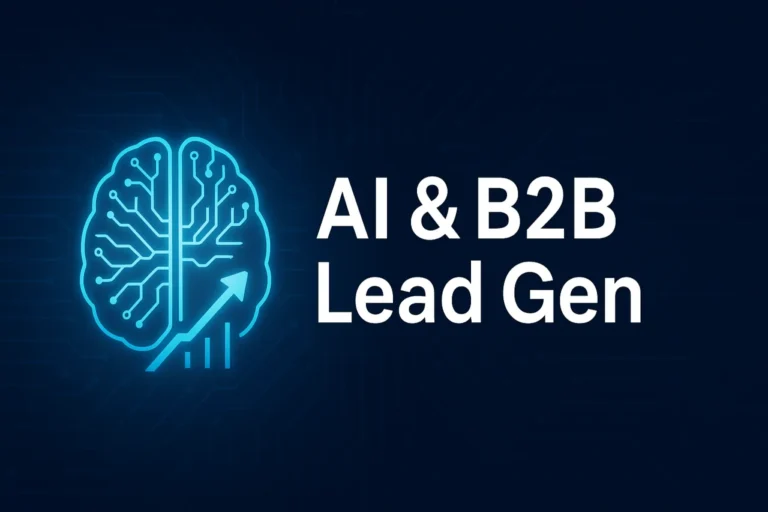B2B Lead Generation vs Demand Generation: What’s the Difference?
You want to grow your business. You know you need leads. But before you launch another campaign or write another ad, you’ve got to answer this:
Are you trying to generate demand or generate leads?
They’re not the same. And mixing them up? That’s where most B2B teams get stuck.
Let’s break it down in plain English.
Lead Generation: Get People to Raise Their Hand
Lead generation is about finding people who might want what you sell—and collecting their contact info. That’s it.
You’re not selling yet. You’re just trying to connect with the right people—names, emails, phone numbers—so your sales team can start a conversation.
Here’s what lead gen usually looks like:
- A cold email that asks someone to book a call
- A LinkedIn message to a decision-maker
- A form on your site in exchange for a free checklist or whitepaper
- A webinar that asks for sign-ups
The goal? Get someone to show interest—enough to start a real sales conversation.
You’re filling the pipeline with potential buyers.
Demand Generation: Make People Want What You Sell
Demand generation is bigger-picture. You’re not collecting contact info right away. You’re planting seeds.
You’re creating awareness, building trust, and teaching your audience why your product or service matters.
This can be:
- A blog post that answers a common industry question
- A podcast episode with helpful insights
- A social media post that tells a real customer story
- A short video that explains how to solve a problem
No sales pitch. Just value.
You’re not asking for anything. You’re giving something first—so when your audience is ready to buy, they already know who you are.
So, What’s the Real Difference?
It’s simple:
- Lead gen is about contact details.
- Demand gen is about creating interest.
Here’s another way to look at it:
| Lead Generation | Demand Generation | |
| Goal | Get leads for your sales team | Get your audience to care |
| Timeline | Short-term | Long-term |
| Method | Forms, outreach, downloads | Content, education, storytelling |
| Ask | “Let’s talk” | “Here’s something useful” |
One gets people into your pipeline. The other makes sure they actually want to be there.
Why B2B Companies Need Both
If you focus only on lead gen, you might get names—but not interest. You’ll have a list of people who barely know you and don’t really care.
If you only focus on demand gen, you’ll educate a lot of people—but without a clear next step, they may never take action.
The smartest B2B companies in 2025 are doing both—at the same time.
They’re using demand generation to:
- Build trust
- Show expertise
- Stay top of mind
Then they’re using lead generation to:
- Reach out
- Book meetings
- Close deals
Here’s an Example:
A company might publish a blog post titled:
“How SaaS Companies Waste Money on Sales Hiring” → (that’s demand gen)
At the end, they offer a guide:
“Free Checklist: 10 Ways to Cut SDR Costs This Quarter” → (that’s lead gen)
Someone downloads it. That’s a lead. Now the sales team has a reason to follow up—based on real interest.
Why This Matters in 2025
Here’s the truth: buyers are smarter now. They do their own research. They don’t want to talk to sales reps unless there’s a good reason.
If your only strategy is sending cold emails to a list, you’ll lose.
At the same time, if all you do is “build awareness” without any follow-up plan, your pipeline dries up.
The winning approach?
- Educate your market
- Add value before you sell
- Follow up with people who are already paying attention
Demand and lead gen aren’t separate silos—they’re parts of the same buyer journey.
When to Use Which
Use lead generation when:
- You have a clear offer and sales process
- You need meetings and pipeline now
- Your product solves an immediate problem
Use demand generation when:
- Your audience needs education before they buy
- You’re launching something new
- You’re in a crowded market and need to stand out
But again—it’s not either-or. It’s both.
Build trust. Start conversations. Win deals.
Final Thoughts
If you’ve been treating lead gen and demand gen as the same thing, now’s the time to fix that.
One gives your team names to call. The other makes sure those names want to hear from you.
They’re different tools—but when used together, they’re powerful.
Want a pipeline that fills itself and actually converts?
Start by helping your buyers. Teach them something real.
Then give them a reason to reach out.
That’s the strategy that wins today. And tomorrow.







